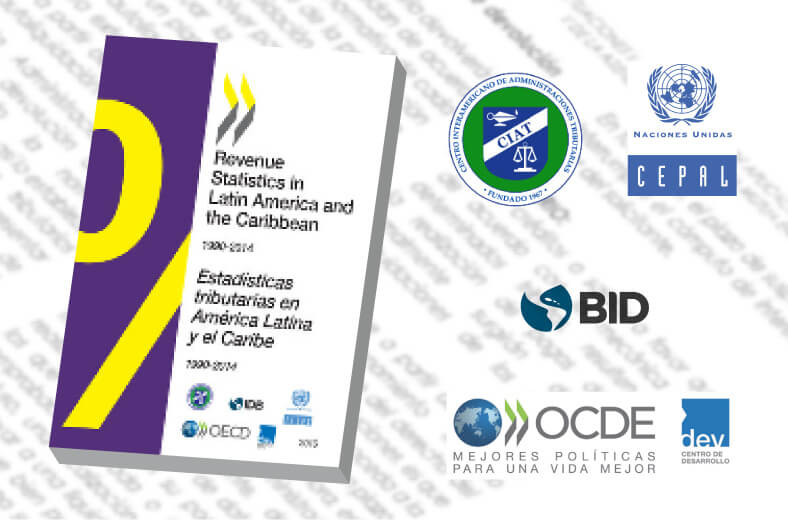Latin America and the Caribbean: Tax revenues rise slightly but remain well below OECD levels

Despite a continuing slowdown in economic growth, tax revenues in Latin American and Caribbean (LAC) countries rose slightly in 2014, as a proportion of national incomes, according to new data from the annual Revenue Statistics in Latin America and the Caribbean publication. The average tax-to-GDP ratio for LAC countries rose from 21.5% in 2013 to 21.7% in 2014, compared with 21.4% in 2012 and 20.8% in 2011.
The report, produced jointly by the Inter-American Centre of Tax Administrations (CIAT), the Economic Commission for Latin America and the Caribbean (ECLAC), the Inter-American Development Bank (IDB), the Organisation for Economic Cooperation and Development (OECD) and the OECD’s Development Centre includes 22 LAC countries. It was launched today during the XXVIII Regional Seminar on Fiscal Policy, held at ECLAC headquarters in Santiago, Chile.
Although tax-to-GDP ratios are increasing across the LAC region, the report highlights that the 21.7% average is still well below the corresponding 34.4% OECD average in 2014.
Countries with higher levels of GDP per capita are more likely to have higher tax-to-GDP ratios, which help to fund investment in infrastructure, education and social services. This relationship is generally reflected in the data presented in the report, as well as in the gap between the LAC and OECD average tax-to-GDP ratios. Widespread levels of informality amongst both firms and workers and higher tax breaks within the LAC region also contribute to the gap. The report stresses that there is scope for further tax base broadening, as well as measures to modernise tax policy and administration to support domestic resource mobilisation, as GDP per capita grows across the region.
The report shows a wide variation across countries. The tax-to-GDP ratios in LAC countries range from 12.6% (Guatemala) and 14.1% (Dominican Republic) to 32.2% (Argentina) and 33.4% (Brazil).
The share of taxes collected by sub-central governments is small in most LAC countries and has not increased, reflecting relatively small taxing powers compared with the same levels of government in OECD countries, according to the report.
A special chapter in the report describes the evolution of revenues from non-renewable natural resources, which have been hit hard by the sharp decline in commodity prices in 2014. This has resulted in a significant reduction in hydrocarbon-related revenues, representing an average 0.7 percentage points of GDP for the countries covered in the special chapter. In 2015, the corresponding expected fall is estimated at 2.1 percentage points of GDP.
These substantial reductions in government revenues from non-renewable natural resources which are not classified as taxes, and therefore are not included in the tax-to-GDP ratios. Mining revenues were similarly affected by the decrease in commodity prices, causing these revenues to fall by 0.1 percentage point of GDP in 2014. The estimated drop for 2015 is expected to be similar to that in 2014. In some countries, increases in mining production coupled with currency depreciations have resulted in relatively stable non-tax revenues. On the other hand, corporate income tax revenues in the sector have fallen sharply as profit margins tightened.
Key findings
Tax to GDP ratios
- The average tax-to-GDP ratio in the group of 22 LAC countries, which includes Trinidad and Tobago, and the Bahamas for the first time, increased from 21.5% in 2013 to 21.7% in 2014. This followed a rise of 1.5 percentage points over the four years between 2010 and 2013, reversing the decline from 20.6% to 19.9% between 2008 and 2009.
- The difference between the OECD average tax-to-GDP ratio and that for the 22 LAC countries fell from 18 to 13 percentage points between 1990 and 2008. The gap has remained steady at 13 percentage points since 2008.
- VAT revenues were responsible for the vast majority of the increase in the average LAC tax burden, which rose from 14.6% to 17.2% between 1990 and 2000. After 2000, revenues from personal and corporate income taxes became the more important driver, and about half of the growth from 17.2% to 21.7% is attributed to these revenues.
- All of the LAC countries showed increases in their tax-to-GDP ratio between 1990 and 2014, though there is considerable variation between individual LAC countries. The countries with the largest increases were Bolivia (20.6 percentage points) and Argentina (19.8 percentage points). These are followed by Colombia, Ecuador and Paraguay which recorded increases of 11-12 percentage points, whereas the increases in Jamaica and Venezuela were 1.2 and 0.1 percentage points respectively.
Tax structures
- Following strong growth over the past twenty-five years, general consumption taxes (mainly VAT and sales taxes) accounted for 31.2% of tax revenues in the LAC countries in 2013 (compared with 20.2% in OECD countries) whereas the share of specific consumption taxes declined to 18.3% (compared to 10.5% in the OECD).
- Taxes on income and profits accounted for 27.4% of revenues on average in the LAC countries and social security contributions represented 16.6% (in OECD the corresponding figures are 33.7% and 26.1% respectively).
Press Contacts:
CIAT Inter-American Centre of Tax Administrations: Neila Jaén, Publication and Communication Coordinator, (njaen@ciat.org, T: + 507 307 2428)
ECLAC: Public Information Unit, Félix Ibáñez, Officer-in-Charge, (prensa@cepal.org, T:+ 56 (2) 22 102 040).
IDB: Office of External Relations, Mildred Rivera, Communication Specialist, mildredr@iadb.org, T: +1 202 6232319
OECD Centre for Tax Policy and Administration, Pascal Saint-Amans, (Pascal.SaintAmans@oecd.org, Cell phone +33 6 26 30 49 23), ein Santiago and Emmanuelle Modica,( Emmanuelle.Modica@oecd.org, T:+33 1 45 24 96 66), en París
OECD Development Centre, Angel Melguizo, (Angel.Melguizo@oecd.org , cell phone: +33 6 01 05 53 34) in Santiago and Bochra Kriout (Bochra.Kriout@oecd.org, Tel: +33 1 45 24 82 96) in Paris
